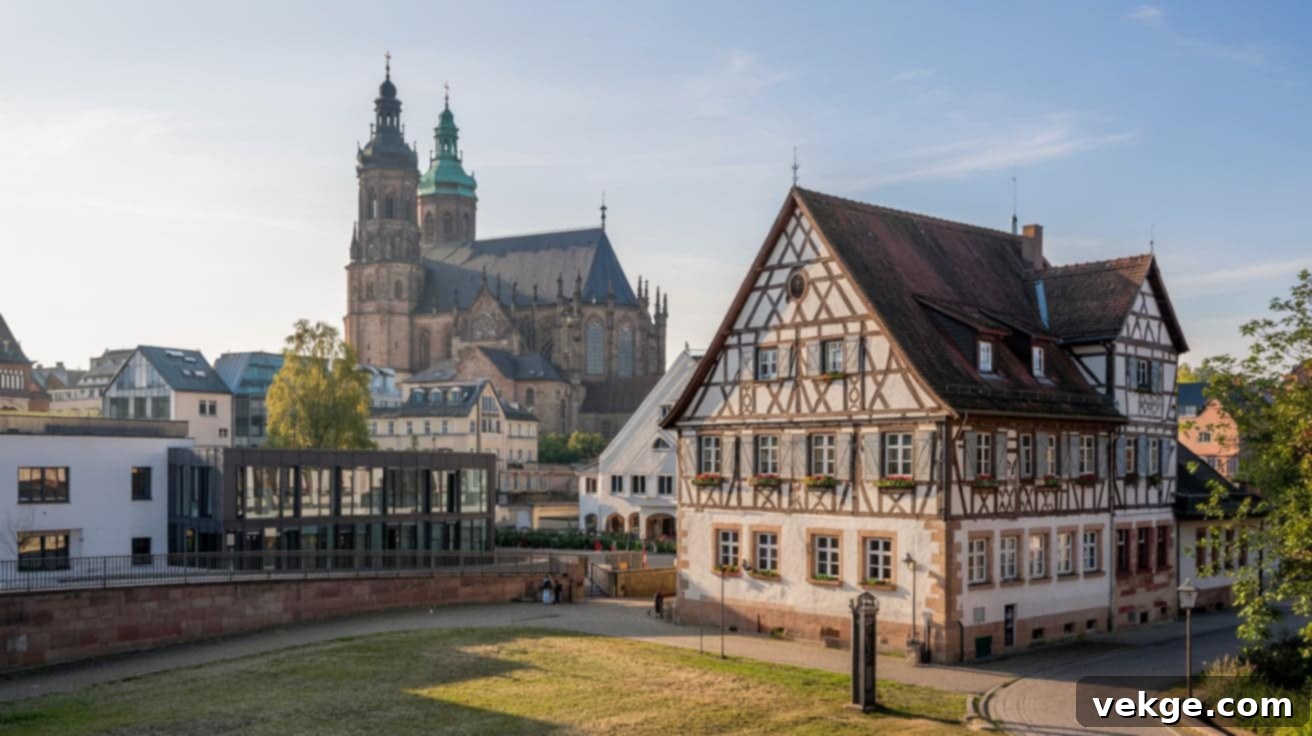Exploring the Enduring Legacy of Traditional German Architecture: History, Styles, and Modern Influences
Germany’s architectural landscape is a captivating blend of ancient traditions and innovative modern designs, shaping its cities, towns, and scenic countryside. This rich tapestry tells a compelling story of the nation’s cultural evolution, resilience, and artistic prowess through centuries.
From the formidable ramparts of medieval castles to the ornate splendor of Baroque palaces, and the charming simplicity of regional vernacular homes, traditional German architecture offers a fascinating journey through time. These structures not only provide shelter but also serve as enduring symbols of local identity, historical events, and the craftsmanship of generations.
In this comprehensive guide, we will delve into the profound history, distinct regional styles, and iconic examples that define German architecture. We will also explore the practical elements that characterize these buildings, the significant efforts made to preserve and restore these architectural treasures, and how traditional forms continue to inspire contemporary design. Join us as we uncover the lasting impact and unique charm of Germany’s remarkable architectural heritage.
What Defines Traditional German Architecture?
Traditional German architecture encompasses the diverse array of building designs and construction methods that have evolved across Germany over many centuries. These styles are deeply rooted in the country’s varied history, rich cultural identity, local customs, and diverse geographical and climatic conditions, which dictated the availability of materials and building necessities.
Originating in the early medieval period, German architecture initially drew heavily from Romanesque styles, visible in the robust construction of early churches, monasteries, and formidable castles. Over time, successive influential periods such as the Gothic, Renaissance, and Baroque eras introduced new aesthetic principles, structural innovations, and artistic expressions. Each period contributed significantly to the distinctive and varied appearance of German buildings, from towering cathedrals to grand civic structures and humble dwellings.
This architectural lineage showcases a remarkable range of practical designs, all while emphasizing an intrinsic beauty and exceptional craftsmanship. Today, the legacy of traditional German architecture is not only admired but actively preserved. Many regions proudly maintain their historic building stock, while others skillfully integrate these ancient forms with modern innovations, creating a harmonious dialogue between the past and the present. This ongoing appreciation ensures that Germany’s architectural heritage remains a vibrant part of its contemporary identity.
Key Architectural Styles in Traditional German Architecture
Germany’s rich architectural tapestry is characterized by several key styles, each possessing unique characteristics that vividly reflect the country’s extensive history, cultural nuances, and profound regional diversity.
1. Half-Timbered Houses (Fachwerkhäuser)
Among the most iconic and instantly recognizable architectural styles in Germany are the half-timbered houses, known as Fachwerkhäuser. These charming buildings are distinguished by their exposed wooden framework, which forms geometric patterns filled in with materials like brick, wattle and daub, or plaster. The dark, often intricately carved, wooden beams create a striking visual contrast against the lighter-colored infill, lending these structures a picturesque and timeless appeal.
Beyond their aesthetic appeal, Fachwerkhäuser hold significant historical and cultural value, particularly in rural and historic town centers. They were ingeniously designed to withstand the local climate, with steeply pitched roofs efficiently shedding heavy snow and rain. The construction method itself, using readily available timber and local infill materials, was both practical and durable. Notable examples, such as the beautifully preserved towns of Rothenburg ob der Tauber, Quedlinburg, and Celle, continue to enchant visitors with their old-world charm, offering a tangible connection to Germany’s past.
2. Bavarian Vernacular Architecture
Bavarian vernacular architecture represents a distinctive traditional style predominantly found in the southern state of Bavaria, particularly within its Alpine and pre-Alpine regions. Buildings in this style are characterized by their simple yet robust construction, designed to integrate seamlessly with the stunning natural landscape.
These homes often present a practical, no-frills appearance, featuring prominent steep roofs and expansive overhangs that offer essential protection from the harsh elements, including heavy snowfall and strong sun. The style deeply reflects the unique Bavarian culture and its challenging climate, with homes built for durability and warmth during long, cold winters. Traditional materials such as local wood, stone, and clay are commonly employed, giving these structures an authentic, earthy feel. This architectural style is intrinsically linked to the region’s agricultural lifestyle, frequently seen in traditional farmhouses, alpine chalets, and rural cottages, often adorned with colorful flower boxes and intricate “Lüftlmalerei” (fresco paintings) depicting local scenes or religious motifs.
3. Romanesque and Gothic Influences
The Romanesque and Gothic styles exerted a monumental impact on German architecture, particularly evident in the country’s many magnificent religious structures. Romanesque architecture, prevalent from the 10th to the 13th centuries, is renowned for its solid, fortress-like qualities. Key features include distinctive rounded arches, immensely thick walls, sturdy pillars, and relatively small, often deeply set, windows. These elements created imposing yet dimly lit interiors, designed to evoke reverence and stability. Prime examples include the Speyer Cathedral and the Mainz Cathedral, both UNESCO World Heritage sites.
Gothic architecture, which followed and flourished from the mid-12th to the 16th centuries, marked a revolutionary departure. It is celebrated for its breathtaking verticality, soaring pointed arches, innovative flying buttresses that allowed for thinner walls, and vast, luminous stained-glass windows. This style aimed to uplift the gaze towards heaven and flood interiors with divine light. Iconic Gothic buildings in Germany include the incomparable Cologne Cathedral, a masterpiece of Gothic engineering and artistry, and the aforementioned Mainz Cathedral, which beautifully blends Romanesque solidity with later Gothic additions. These styles collectively emphasized both structural innovation and spiritual aspiration, creating awe-inspiring and truly unforgettable sacred spaces.
4. Baroque Architecture
German Baroque architecture, flourishing from the 17th to the mid-18th century, is synonymous with drama, grandeur, and opulent ornamentation. Buildings from this period are characterized by their lavish, dynamic designs, featuring grand, undulating facades, intricate stucco work, vibrant frescoes, and expansive, often illusionistic, interiors. The style was widely adopted for royal palaces, magnificent churches, and prestigious government buildings, serving as a powerful expression of wealth, power, and religious fervor.
Baroque design masterfully balanced both breathtaking beauty and practical utility, creating spaces that were both awe-inspiring and functional for courtly life and worship. Notable examples of this magnificent style in Germany include the Residenz Palace in Munich, with its opulent state rooms and splendid gardens, and the Würzburg Residence, recognized as one of Europe’s most exceptional Baroque palaces. These architectural marvels are designed to profoundly impress, leaving visitors in awe of their sheer scale, intricate details, and the masterful artistry of the period.
Key Elements of Traditional German Architecture
Understanding the fundamental elements that constitute traditional German architecture is crucial to appreciating its enduring appeal and functional brilliance. These elements encompass the primary building materials, distinctive roof designs, and the characteristic styles of windows and doors, each contributing significantly to the overall aesthetic, structural integrity, and practical function of these remarkable buildings.
Materials Used in German Architecture
Traditional German buildings exhibit a remarkable diversity in their construction materials, largely dictated by regional availability. Timber, brick, natural stone (such as sandstone and limestone), and slate are among the most prevalent. Wood was a ubiquitous choice, especially for the widespread half-timbered houses, offering flexibility and structural support.
For more enduring and monumental structures like castles, cathedrals, and city fortifications, robust stone and durable brick were favored. The choice of material often tells a story about the local geology and historical trade routes. For instance, the Rhineland region frequently features slate for roofing and facades due to local quarries, while Bavarian homes prominently showcase a combination of timber and stone, reflecting the mountainous terrain. Northern Germany, lacking abundant stone, developed a distinctive “Brick Gothic” (Backsteingotik) style. These regional variations imbue German architecture with its distinctively diverse yet unified character, creating a fascinating mosaic across the country.
Roof Designs
Roof designs in traditional German architecture are not merely aesthetic features but are primarily functional, engineered to contend with the often-harsh European climate, particularly the heavy snowfall typical in many parts of Germany. Steeply pitched, gabled roofs are a hallmark, designed to efficiently shed snow and water, thus protecting the building’s structural integrity and preventing water damage. These prominent roofs also contribute significantly to the overall silhouette and visual character of German towns and cities.
In rural and historically agricultural areas, particularly in the past, thatch roofs were also common. Crafted from straw or reed, these natural roofs provided exceptional insulation, keeping homes warm in winter and cool in summer. While less common in contemporary construction due to fire risks and maintenance, thatched roofs can still be admired on many beautifully preserved traditional farmhouses and cottages, particularly in regions like North Frisia, evoking a sense of timeless rural charm.
Windows and Doors
Windows and doors in traditional German architecture fulfill both essential practical and decorative functions, playing a crucial role in the building’s overall character and climate responsiveness. Window shutters are frequently employed, serving as a vital protective barrier against inclement weather, while also adding significant visual appeal. In many traditional buildings, shutters are painted in vibrant, often contrasting, colors, lending a unique charm and liveliness to the facades.
Doors are typically crafted from sturdy wood, often featuring intricate carvings, decorative metalwork, or robust hardware. In Germany, the design of main entryways often emphasizes a welcoming and inviting nature, with grand or stately doors frequently opening onto charming courtyards, well-tended gardens, or directly into communal spaces. These elements collectively reflect a practical yet aesthetically conscious approach to design, where every detail serves a purpose while contributing to the building’s distinctive identity.
Notable Examples of Traditional German Architecture
Germany is home to an extraordinary collection of architectural masterpieces, each narrating a unique story of its construction, purpose, and the era it represents. These iconic buildings beautifully showcase various styles, from the awe-inspiring Gothic to the opulent Baroque and the quaint charm of half-timbered houses. They stand as powerful symbols of Germany’s rich history, profound cultural pride, and remarkable engineering prowess.
1. Neuschwanstein Castle
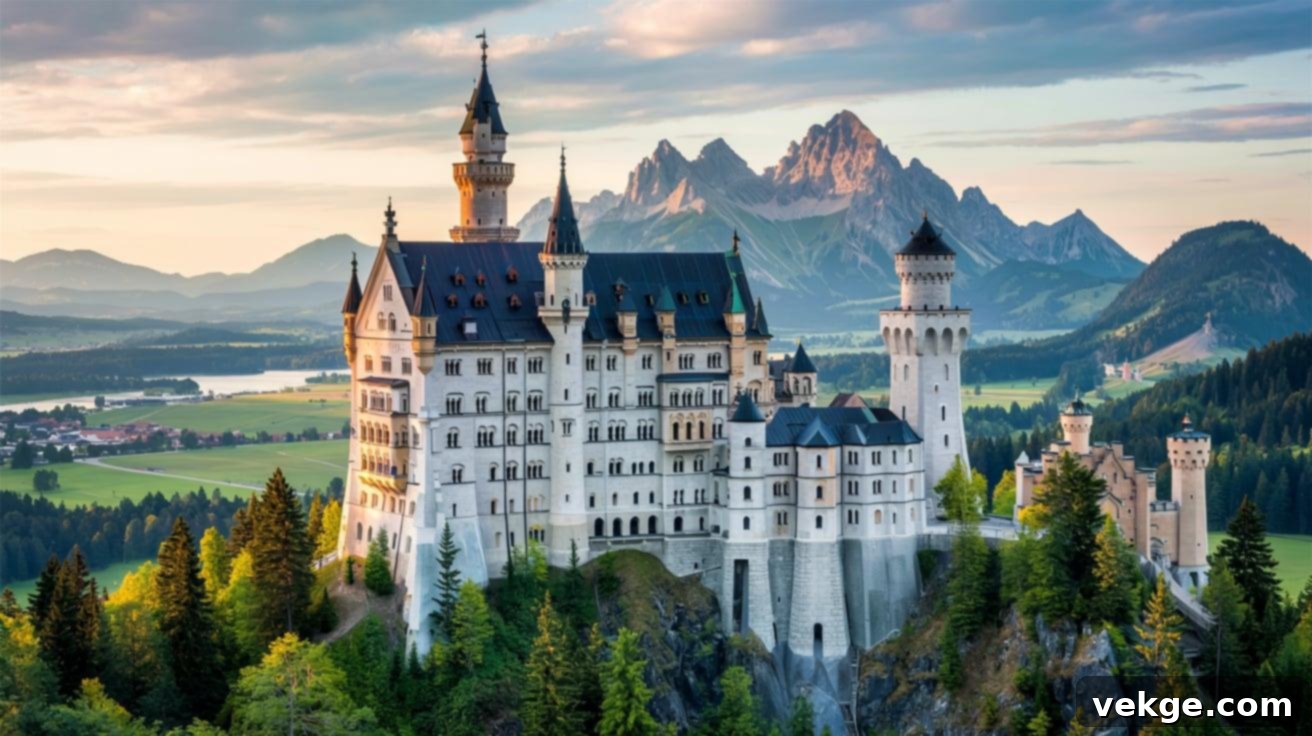
Perched majestically on a rugged hill amidst the stunning Bavarian Alps, Neuschwanstein Castle is a fairytale come to life. Commissioned by the eccentric King Ludwig II of Bavaria and constructed between 1869 and 1886, this castle is a fantastical blend of medieval romanticism and 19th-century vision. Its soaring white limestone walls, elegant turrets, and towering spires evoke a sense of mythical grandeur, famously inspiring Walt Disney’s Sleeping Beauty Castle.
The interior rooms are a lavish spectacle, adorned with intricate frescoes and elaborate decorations depicting scenes from German legends and the operas of Richard Wagner, whom Ludwig deeply admired. The grand Throne Room, though never housing a throne, features a breathtaking mosaic floor composed of over 2 million stones. Despite its ancient appearance, Neuschwanstein was remarkably modern for its time, incorporating advanced features such as central heating, running water on all floors, and even telephones.
Tragically, Ludwig lived in his dream castle for only 172 days before his mysterious death. Today, over 1.4 million visitors flock to Neuschwanstein annually, making it one of Germany’s most photographed and beloved architectural wonders, a true testament to the power of imagination and romantic ideals.
2. Cologne Cathedral (Kölner Dom)
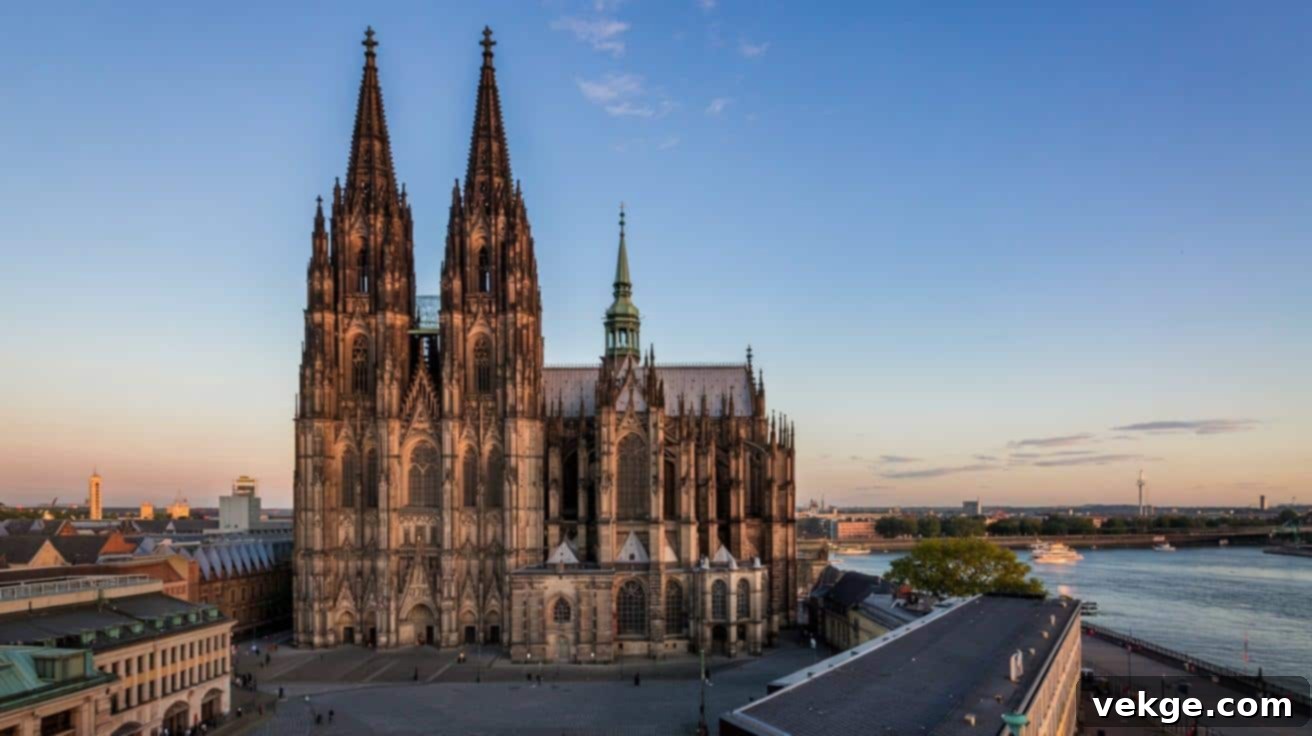
A towering testament to human endurance and Gothic ambition, the Cologne Cathedral is one of Germany’s most significant architectural achievements. Its construction spanned an astonishing 632 years, from 1248 to 1880, resulting in the largest Gothic church in Germany and a universally recognized masterpiece of Gothic architecture. Its two magnificent spires ascend to a breathtaking height of 157 meters, making it the tallest twin-spired church in the world and an undeniable landmark on the Cologne skyline.
The cathedral is more than just a magnificent structure; it is a repository of history and sacred relics. It proudly houses the Shrine of the Three Kings, believed to contain the remains of the biblical Magi, making it a major pilgrimage site. Its vast stained glass windows, covering an area of 10,000 square meters, include some of the oldest dating back to 1260, casting ethereal light into the cavernous interior.
Miraculously, this colossal edifice largely survived the intense Allied bombing raids of World War II, even as much of Cologne lay in ruins around it, a testament to its robust construction. Recognized by UNESCO as a World Heritage site in 1996, the Cologne Cathedral continues to function as a vibrant working church with daily services, welcoming approximately 20,000 visitors and worshippers each day, standing as an enduring symbol of faith, art, and resilience.
3. Heidelberg Castle
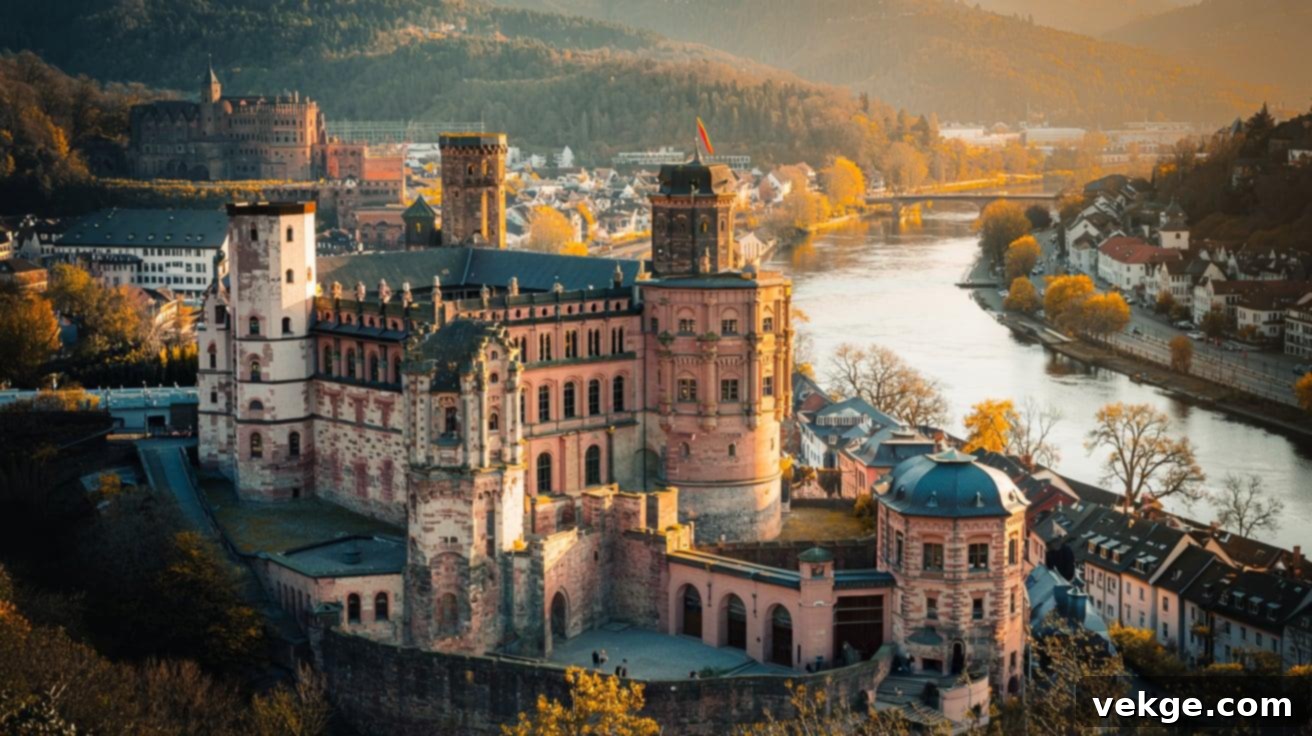
Perched majestically on a hillside overlooking the scenic Neckar River and the charming town of Heidelberg, Heidelberg Castle is a dramatic ruin embodying both Gothic robustness and Renaissance elegance. Constructed in various stages from the 13th to the 17th centuries, it served as the formidable residence for the powerful Electors Palatine.
Throughout its history, the castle suffered extensive damage from lightning strikes, wars, and fires, leaving significant portions in picturesque ruins – a state that ironically enhanced its romantic appeal. Among its many intriguing features is the Great Barrel in the cellar, an enormous wine vat with a capacity of 219,000 liters, famously topped with a dance floor. The Friedrich Building, a stunning Renaissance palace within the complex, showcases exquisite craftsmanship with its detailed sculptures of German rulers and mythological figures.
The castle gardens, known as Hortus Palatinus, once among the most celebrated Renaissance gardens in Europe, still offer breathtaking panoramic views of the old town below. These romantic ruins gained immense fame during the Romantic period of the 19th century, attracting countless artists, poets, and writers who immortalized its beauty in their works, effectively establishing it as one of Germany’s first major tourist attractions and a symbol of German romanticism.
4. Dresden’s Zwinger Palace
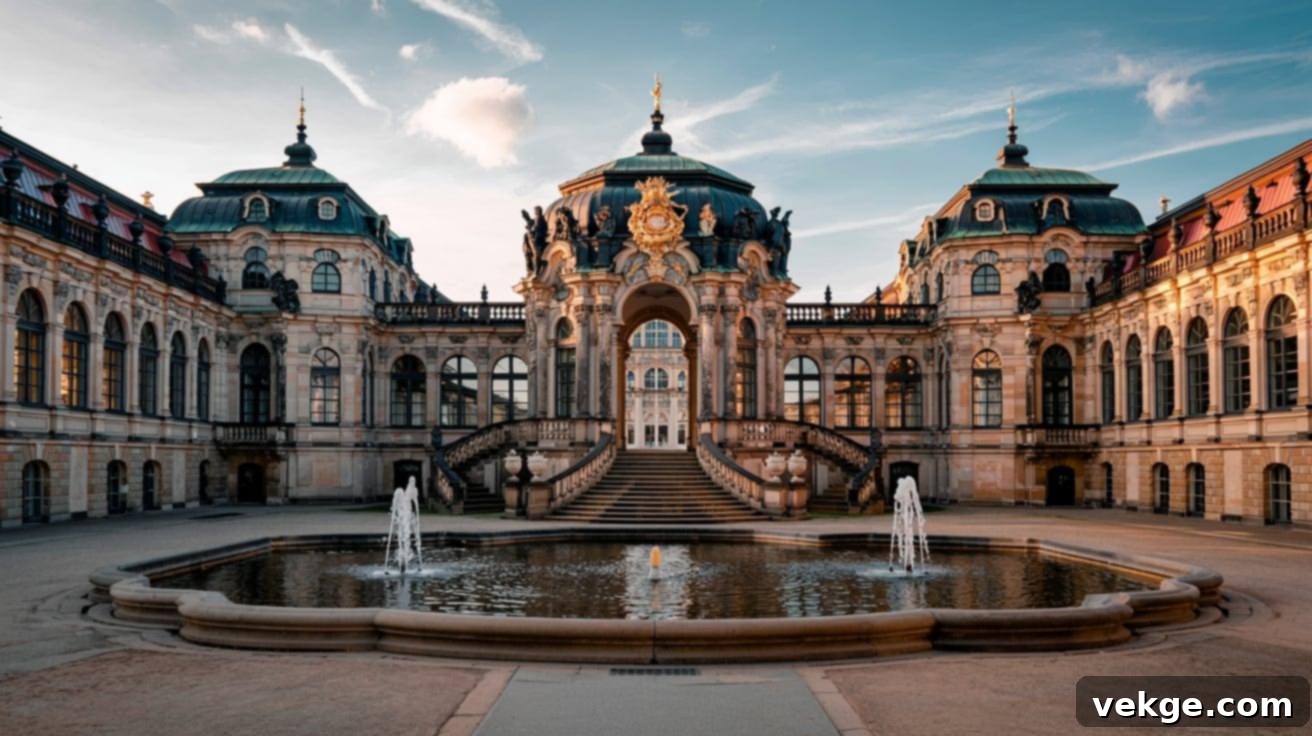
The Zwinger Palace in Dresden is a magnificent example of High Baroque architecture, constructed between 1710 and 1728 under the ambitious patronage of Augustus the Strong, Elector of Saxony and King of Poland. This stunning complex comprises a series of ornate pavilions connected by elegant galleries, enclosing a vast, open courtyard that was once used for court festivities, tournaments, and lavish outdoor events.
The iconic Crown Gate (Kronentor) entrance is a masterpiece in itself, featuring sweeping curved stairs, intricate sculptural details, and gleaming golden ornaments. Within the central courtyard, elaborate fountains adorned with classical figures and water nymphs create a serene and almost theatrical garden atmosphere. Today, the Zwinger houses several world-renowned museums, including the Old Masters Picture Gallery, a magnificent porcelain collection, and the Royal Cabinet of Mathematical and Physical Instruments.
Despite being largely destroyed during the devastating firebombing of Dresden in 1945 during World War II, the Zwinger was meticulously and faithfully rebuilt, a testament to its cultural significance and the dedication of restoration efforts. The Nymphenbad (Bath of Nymphs) fountain area, with its shell-shaped cascades and mythological figures, remains a particularly enchanting spot, making the Zwinger a beloved destination for both tourists and locals alike, celebrating the grandeur of the Baroque era.
5. Bamberg’s Historic Old Town
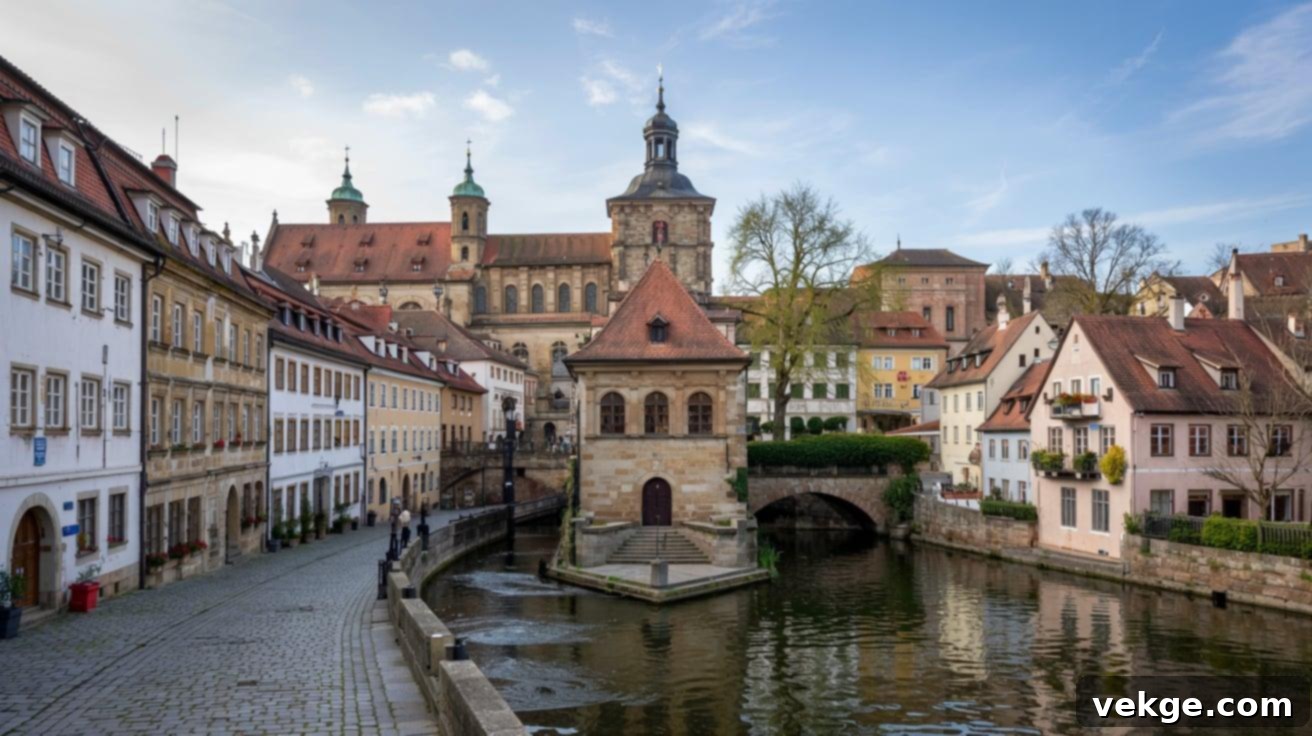
Bamberg’s Historic Old Town stands as an exceptionally well-preserved testament to a millennium of European urban planning and architectural evolution. Miraculously surviving World War II largely intact, this medieval gem boasts 1,000 years of building history. The town gracefully sprawls across seven picturesque hills, each crowned with a church, earning it the endearing nickname “Franconian Rome.”
Its unique layout vividly illustrates the intricate workings of medieval town planning, featuring distinct, organically grown areas for ecclesiastical power, noble residences, and the common citizenry. The iconic Old Town Hall (Altes Rathaus) holds a legendary status, ingeniously built on an artificial island in the Regnitz River, a clever solution when the powerful bishop refused to grant citizens land for their administrative building. Narrow, winding streets, lined with charming half-timbered houses and quaint shops, lead to the majestic Imperial Cathedral, a Romanesque-Gothic masterpiece distinguished by its four imposing towers.
A particularly enchanting district, affectionately known as “Little Venice” (Klein Venedig), features former fishermen’s houses clustered directly along the riverbanks, their small gardens stretching down to the water. In 1993, UNESCO recognized the entire Old Town of Bamberg as a World Heritage Site, celebrating its outstanding universal value as a living example of a central European town from the early Middle Ages to the Baroque period.
Regional Differences in German Architecture
German architecture is a fascinating amalgamation of styles that powerfully reflects the country’s extensive history, diverse cultural landscape, and distinct regional characteristics. These variations are often influenced by local building materials, climate, and historical developments.
Bavarian Architecture
Bavarian architecture, particularly evident in the southern Alpine and pre-Alpine regions, exhibits strong influences from its mountainous environment. Houses in this style typically feature wide, overhanging roofs designed to efficiently manage heavy snow and abundant rainfall. Wooden elements are paramount, often showcasing intricately carved balconies, decorative eaves, and the distinctive “Lüftlmalerei” – vibrant fresco paintings on facades depicting local scenes, religious figures, or historical events, adding a unique charm.
Churches, such as the exquisite Wieskirche, often boast rounded domes and bright, highly ornate interiors, reflecting the Baroque and Rococo influences that flourished in the region. The world-famous Neuschwanstein Castle, while a romanticized 19th-century creation, draws heavily on medieval styles, combining them with fantasy elements that evoke the rugged Bavarian landscape. Rural homes are frequently adorned with colorful flower boxes spilling from windowsills and proudly display exposed wooden beams, creating a quintessential picturesque image. This style is deeply interwoven with the majestic mountain landscape and the ingenious use of local building materials, making it instantly recognizable and deeply cherished.
Northern German Brick Architecture
In contrast to the stone-rich south, the flat, often marshy lands of Northern Germany naturally lacked abundant stone. Consequently, brick became the primary and most defining building material. This led to the emergence of the distinctive Backsteingotik (Brick Gothic) style, which spread robustly through the powerful Hanseatic trading cities along the Baltic Sea, such as Lübeck, Wismar, Stralsund, and Rostock.
These affluent cities constructed their grand churches, imposing city gates, and stately town halls almost exclusively using dark red bricks, often arranged in complex, decorative patterns. St. Mary’s Church in Lübeck serves as a prime example, demonstrating how master builders ingeniously created soaring pointed arches, intricate tracery, and high vaulted ceilings using only brick, pushing the material’s structural and aesthetic limits. City walls, vast warehouses, and the elaborate homes of wealthy merchants all utilized this practical yet highly artistic material. The style is further characterized by decorative elements like glazed bricks in varying colors and distinctive stepped gables on building fronts, creating a cohesive and visually striking architectural identity across the region.
Frankish and Swabian Styles
The regions of Franconia (in northern Bavaria) and Swabia (in Baden-Württemberg) developed distinct architectural approaches, often characterized by a blend of practicality and regional artistry. Franconian towns, like the aforementioned Rothenburg ob der Tauber and Bamberg, are famous for their well-preserved historic centers featuring homes with steeply pitched roofs and characteristic half-timbered upper floors, often with intricately carved details. Natural limestone, readily available from local quarries, became a common and durable building material, especially for ground floors and public buildings.
Swabian architecture, on the other hand, often includes the distinctive “Swabian Hall” house type, recognizable by its central entrances and a more symmetrical, organized design, reflecting a practical and orderly approach. Both areas feature modest yet functional town centers, typically centered around practical market halls and public fountains. Windows in these regions tend to be smaller than in the more ornate southern Bavarian styles, and buildings often cluster closely together, a design choice influenced by the need for warmth and efficient use of urban space. Churches in these regions generally favor simpler stone construction with limited external decoration, prioritizing solid craftsmanship and structural integrity over flamboyant details, creating a dignified and understated architectural presence.
Role of Traditional German Architecture in Today’s Society
Traditional German architecture continues to play a pivotal and multifaceted role in contemporary society, extending far beyond mere aesthetic appreciation. It serves as a vital bridge, connecting people to their profound cultural heritage, informing urban planning, and inspiring sustainable design practices globally.
Cultural Significance
- Traditional German architecture is inextricably linked to Germany’s cultural identity. Iconic structures, such as the ubiquitous half-timbered houses, the majestic castles, and the grand cathedrals, serve as tangible narratives of the country’s rich, complex history and the exceptional craftsmanship of its people throughout the ages.
- These diverse buildings are powerful expressions of national pride and showcase the remarkable regional diversity that defines Germany. From the Hanseatic brick of the north to the Alpine chalets of the south, each style tells a unique story of local traditions, available resources, and cultural values.
- Actively preserving this architectural legacy is paramount, as it helps to maintain a crucial, living connection to the past. It offers invaluable insights into historical construction methods, societal structures, and artistic developments.
- Ultimately, safeguarding and celebrating this architecture ensures that Germany’s architectural heritage remains vibrant, accessible, and meaningful for current and future generations, fostering a sense of continuity and collective memory.
Preservation and Restoration
- The preservation and meticulous restoration of traditional German buildings are absolutely key to maintaining and celebrating the nation’s invaluable cultural heritage. This involves a dedicated commitment to protecting historical integrity while ensuring structures remain viable and functional.
- Significant efforts, such as the remarkable reconstruction of the Dresden Frauenkirche after its total destruction in World War II, exemplify this dedication. Such projects ensure that traditional craftsmanship, historic building techniques, and architectural knowledge are not lost but rather kept alive and passed down.
- Restoration often combines cutting-edge modern techniques and materials with traditional methods, striking a delicate balance to preserve the authentic essence and historical patina of these structures while enhancing their stability and longevity.
- This careful process not only makes historic buildings functional for contemporary use but also ensures they retain their profound historical and cultural significance, allowing them to continue inspiring and educating.
Influence on Global Architecture
- Traditional German architectural elements, such as the distinctive half-timbered houses, the practical steep gabled roofs, and the robust use of local materials, have exerted a significant and often underestimated influence on global design.
- These characteristic elements spread extensively throughout Europe and overseas, particularly in regions settled by German immigrants or influenced by German trade and cultural exchange, such as parts of North America and Eastern Europe.
- Beyond specific forms, the inherent focus on sustainability, durability, and the judicious use of natural and local materials in traditional German architecture continues to profoundly impact and inspire modern architectural designs worldwide.
- Traditional German architecture thus remains a potent source of inspiration for innovative contemporary projects, showcasing how historical precedents can be harmoniously blended with modern needs and aesthetic sensibilities, proving its timeless relevance.
Modern Influences on Traditional German Architecture
The dialogue between modern design principles and traditional German architecture is an ongoing and dynamic process. Contemporary structures frequently incorporate new materials and advanced technology while consciously retaining the enduring charm, aesthetic principles, and functional wisdom embedded in traditional designs, creating a unique architectural narrative.
Post-War Architecture
Following the immense devastation of World War II, numerous German cities faced the monumental task of rebuilding. This period saw a fascinating interplay where traditional architectural styles were thoughtfully integrated with modern materials and construction techniques. The primary aim was two-fold: to rapidly address critical housing shortages and restore a sense of cultural identity and historical continuity that had been shattered.
Many towns and urban centers consciously employed familiar traditional elements, such as steeply pitched roofs, recognizable window proportions, and even abstracted timber framing, blending them with new building technologies like concrete and steel. This approach allowed for efficient reconstruction while simultaneously preserving a connection to historical aesthetics, ensuring that the new urban fabric resonated with the city’s past, rather than completely erasing it. It was a challenging balancing act between necessity, memory, and progress.
Contemporary Architecture with Traditional Elements
Today, modern German architects continue this tradition of blending, creating a seamless and often sophisticated connection between the old and the new. Contemporary designs frequently pay homage to Germany’s rich architectural past by subtly incorporating traditional features into innovative structures, rather than merely replicating historical styles.
Elements like the clean lines of timber framing, the functional elegance of steep roofs, or the distinctive rhythm of window arrangements are often reinterpreted in modern designs. These contemporary structures can be found across various building types, from striking public buildings and cultural centers to sustainable residential homes. This approach honors Germany’s profound architectural heritage while simultaneously meeting the complex demands and aesthetic preferences of contemporary living, demonstrating a continuous evolution rather than a break from tradition. It reflects a deep respect for historical context combined with a forward-looking vision for design.
Conclusion
Traditional German architecture offers a truly unique and immersive glimpse into the country’s profound history, diverse cultural expressions, and remarkable regional characteristics. From the foundational strength of early Romanesque styles to the aspirational heights of Gothic cathedrals, and the sumptuous grandeur of Baroque and Rococo palaces, each era has left an indelible mark on Germany’s built environment, shaping its identity.
This enduring architectural legacy is not static; modern influences continuously interact with and reshape it, fostering a vibrant dialogue that skillfully blends the old with the new. This continuous evolution ensures that Germany’s cities and landscapes remain dynamic and historically rich.
The active preservation, meticulous restoration, and informed understanding of these magnificent structures are essential. They not only help to maintain a vital, tangible connection to Germany’s past but also serve as invaluable guides and inspirations for future architectural developments, influencing design principles and sustainable practices.
This article has highlighted the immense importance of traditional German designs and illustrated how they continue to inspire innovative modern architecture, not only within Germany but across the globe. Their timeless appeal, functional elegance, and deep cultural resonance ensure that Germany’s architectural heritage will continue to captivate and educate for generations to come.
Interested in learning more about fascinating architectural styles, design principles, and their global impact? Be sure to explore our other engaging blogs for more tips, inspiring ideas, and deeper insights into the world of architecture and design.
